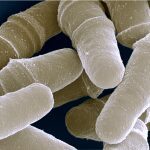Lien vers Pubmed [PMID] – 24748152
PLoS ONE 2014;9(4):e95788
Rad52 is a key protein in homologous recombination (HR), a DNA repair pathway dedicated to double strand breaks and recovery of blocked or collapsed replication forks. Rad52 allows Rad51 loading on single strand DNA, an event required for strand invasion and D-loop formation. In addition, Rad52 functions also in Rad51 independent pathways because of its ability to promote single strand annealing (SSA) that leads to loss of genetic material and to promote D-loops formation that are cleaved by Mus81 endonuclease. We have previously reported that fission yeast Rad52 is phosphorylated in a Sty1 dependent manner upon oxidative stress and in cells where the early step of HR is impaired because of lack of Rad51. Here we show that Rad52 is also constitutively phosphorylated in mus81 null cells and that Sty1 partially impinges on such phosphorylation. As upon oxidative stress, the Rad52 phosphorylation in rad51 and mus81 null cells appears to be independent of Tel1, Rad3 and Cdc2. Most importantly, we show that mutating serine 365 to glycine (S365G) in Rad52 leads to loss of the constitutive Rad52 phosphorylation observed in cells lacking Rad51 and to partial loss of Rad52 phosphorylation in cells lacking Mus81. Contrariwise, phosphorylation of Rad52-S365G protein is not affected upon oxidative stress. These results indicate that different Rad52 residues are phosphorylated in a Sty1 dependent manner in response to these distinct situations. Analysis of spontaneous HR at direct repeats shows that mutating serine 365 leads to an increase in spontaneous deletion-type recombinants issued from mitotic recombination that are Mus81 dependent. In addition, the recombination rate in the rad52-S365G mutant is further increased by hydroxyurea, a drug to which mutant cells are sensitive.

